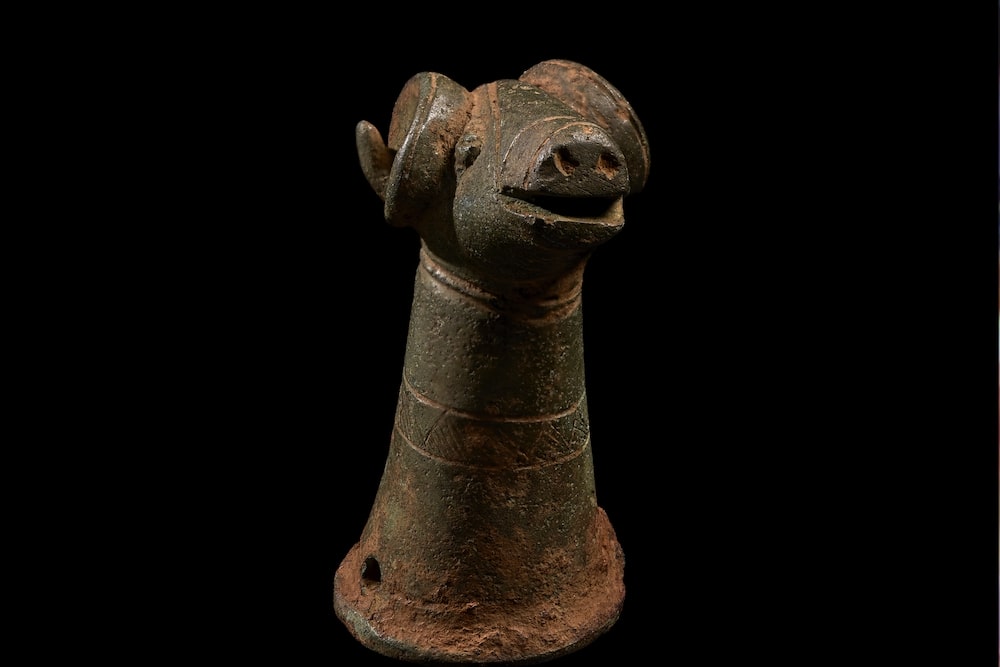Unusual metal-detecting find in Wales is declared treasure

A group of sixteen artefacts of Iron Age and Roman date have been declared treasure.
They come from a discovery made by metal detectorist Ian Porter on 4th March 2020 while metal-detecting on a field under pasture in Llanfair-Mathafarn-Eithaf Community, Anglesey.
The find was first reported to Sean Derby, Finds Liaison Officer of the Portable Antiquities Scheme in Wales (PAS Cymru) based at Gwynedd Archaeological Trust. It was subsequently reported on as a treasure find by expert archaeological curators based at Amgueddfa Cymru – Museum Wales.
The artefact group includes a number of Iron Age chariot fittings dating to the later first century AD and Roman cavalry fittings of similar date. These include parts of three bridle-bits, a terret (or rein-guide), a ram’s head fitting and a set of four harness discs known as phalerae. A large and complete Roman copper ingot weighing 20.5kg was also discovered, probably smelted copper deriving from the nearby Roman copper mine at Parys Mountain. The additional artefacts, all of Roman date, include a decorated brooch, four coins and a lead pot repair.
The artefacts were all discovered near and around where a spring emerges in a boggy area of a modern field, liable to waterlogging.
These unusual bronze, copper and lead artefacts are thought to have been gifted as repeated religious offerings around an ancient sacred spring source during the Late Iron Age and into the Romano-British period.
The chariot fittings, cavalry harness pieces and brooch were all placed around AD 50-120, around the time of, or soon after the invasion of the island by the Roman army in AD 60/61. The coins and other artefacts suggest a continuing practice of votive gifting around the spring throughout the Roman period, the latest coin in the group being struck around AD 364-378.
The finder, Ian Porter, said: “I was so excited when I found these items. To think that the last person who touched them lived almost two thousand years ago and it shows some of the history of the island”.
Adam Gwilt, Principal Curator for Prehistory at Amgueddfa Cymru – Museum Wales said: “This culturally mixed artefact group, containing both Iron Age chariot fittings and Roman cavalry fittings, is an important new find for the island.
“It was placed during or in the aftermath of the period of invasion of the island by the Roman army. This dramatic event is vividly captured by the Roman author Tacitus, writing about the strange first encounter between Roman soldiers and Druids on Anglesey.
“This group of gifted objects illustrates how watery locations, including the sacred lake site at Llyn Cerrig Bach, were seen as significant places for religious ceremony at this time of conflict and change.
“The ram’s head fitting, probably a vehicle-fitting or staff-head is decorated in the late Celtic art style. It is a closely observed and quirky depiction of the ram and a likely future ‘star’ exhibit loved by many for Oriel Môn!”
Ian Jones, Building and Collections Manager at Oriel Môn, said: “Since the discovery of the Iron Age artefacts from Llyn Cerrig Bach during the 1940s, Anglesey has long been associated with this important period in our history.
“This exciting new find from the island will enhance our understanding and knowledge, and Oriel Môn is pleased to collaborate with Amgueddfa Cymru and is eager to acquire it for our collection.
“The items themselves and nature of how they were deposited are of immense archaeological significance and will provide us with a great deal of potential in terms of display and interpretation. It will also offer fantastic outreach and educational opportunities. We understand that items from this period are of interest to our visitors, so this is thrilling news for us all.”
Oriel Môn has expressed an interest in acquiring this artefact group for its collection after it has been independently valued by via the Treasure Valuation Committee.
Each year, between 50 and 80 treasure cases are reported in Wales, as finds made by members of the public, usually metal detectorists. Since 1997, over 700 treasure finds have been made in Wales, with numbers of treasure finds gradually increasing over time, with 77 treasure cases reported in 2023. These finds are adding important new knowledge and understanding of our pasts, a cultural resource of growing importance for Wales.
Treasure items must be legally reported and handed over to PAS Cymru staff and Amgueddfa Cymru – Museum Wales, as the lead heritage organisation managing treasure work in Wales. National museum curators gather accurate information and report on treasure finds, making recommendations to coroners, the officers who make independent legal judgements on treasure and ownership.
Support our Nation today
For the price of a cup of coffee a month you can help us create an independent, not-for-profit, national news service for the people of Wales, by the people of Wales.







Nothing is ever “Welsh” in Wales!!!
I wonder how long it takes for these artefacts to wing their way to England.
Iron age, so we don’t have to mention the locals. It was a wasteland before the English speaking Romans showed up.